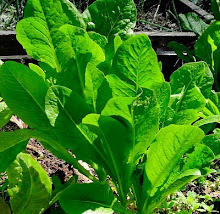Certain farming practices can trap a majority of greenhouse gas (GHG) emissions. On a global scale, this could even lead to a net decrease in atmospheric greenhouse gas levels — or, in other words, help reverse climate change.
By Skylar Lindsay, FoodTank September 3, 2014
A recent study by the Rodale Institute documents how specific organic farming practices can trap a majority of greenhouse gas (GHG) emissions. On a global scale, this could even lead to a net decrease in atmospheric greenhouse gas levels — or, in other words, help reverse climate change.
The study, “Regenerative Organic Agriculture and Climate Change: A Down-to-Earth Solution to Global Warming,” highlights soil’s natural ability to trap carbon from the atmosphere. This process, called carbon sequestration, occurs when photosynthesis removes carbon from the air faster than other biological processes, like respiration, release it.
According to the Rodale, if half of the world’s croplands were shifted to regenerative methods, the world could reduce net annual greenhouse gas emissions from 51 gigatons of carbon dioxide equivalent to below 41– the threshold necessary by 2020 to limit global warming to 1.5º C.
The figures are based on 75 peer-reviewed studies and on test sites throughout the world where organic and conventional methods are compared side by side. These include Rodale’s long-running Farming Systems Trial (FST) in the United States and more recent Tropical Farming Systems Trial in Costa Rica. Rodale uses this data to calculate a rate of carbon sequestration per area of land cultivated, and then scale-up to see the impact of global adoption of each practice.
For example, if all current cropland were cultivated using methods tested in Iran and Egypt, 21 gigatons of carbon dioxide equivalent (GtCO₂e), or 40 percent of global emissions, could be sequestered annually. If applied to the world’s pasture and grassland, Rodale calculates its recommendations could sequester 37 GtCO₂e, or over 70 percent of emissions. Changing the cultivation of cropland, pasture, and grassland together could lead to a net reduction in the greenhouse gases in our atmosphere.
Rodale’s recommendations focus on soil health, biodiversity, and avoiding farming methods that contribute to a net release of carbon including the overuse and misuse of pesticides, artificial fertilizers, and unnecessary tilling. The regenerative techniques include crop rotation, cover crops, mulching and green manure, composting, and no-till practices.
Cover cropping techniques increase soil carbon via photosynthesis and better carbon retention in topsoil layers. Perennial cover crops, called living mulches, are especially effective due to large, deep root systems. Strategic crop rotations increase soil carbon levels, and coupled with on-farm composting and cover cropping, encourages soil microbes that absorb carbon. These regenerative practices also help carbon-absorbing fungi populations.
Skylar Lindsay majors in Peace & Conflict Studies at Colgate University, where he heads the organic farming initiative and leads for the Outdoor Education program.
http://www.csmonitor.com/Business/The-Bite/2014/0903/How-changing-the-way-we-farm-could-reduce-greenhouse-gas-emissions
Subscribe to:
Posts (Atom)





